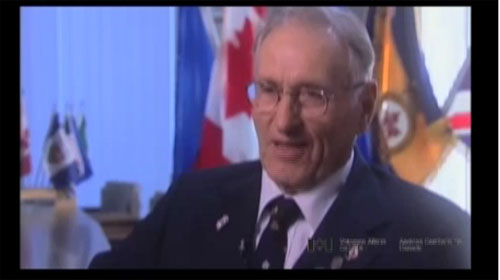Interviewer: Are you proud of the service that
you and your comrades gave to Canada?
Oh yes, I think we're proud of our
regiment and our service.
Interviewer: Can you explain to me a
little bit about your regiment?
What regiment you belonged to?
It was the 8th Canadian Reconnaissance
Regiment, and we were an
armoured reconnaissance.
We were the eyes for the 2nd Division.
There was four squadrons.
There was Headquarters Squadron,
and A, B and C, and one squadron
was attached to each of the brigades.
There was three brigades in the 2nd Division
of infantry, and so one squadron would be
attached to each.
We never fought together as a regiment.
We were the eyes for whatever brigade
we were attached to. Sometimes we'd be
quite a ways ahead of the infantry,
because that was your job, to go out
and scout what was ahead of you.
Sometimes it was foot patrols.
And of course, the infantry regiments
had foot patrols, too, but ours was
an armoured one, and we were
supposed to go farther.
Interviewer: So when you say you were
the eyes, how did you report back as to
what you were seeing?
Well, you come back, but you also radio.
Some of the cars, Bren gun cars,
and some of the trucks too, I guess,
they had radios they operated.
They were signallers, you know.
The signaller corps.
Some of them were attached to us,
too, but every regiment has its own signals,
you know, so you can talk from one part
of the regiment to another.
If you sent out a patrol, they've gotta be
able to report back, either if they can't
do it that way, they come back on foot.
You try and find where their headquarters
was or where there was an ambush set up.
Like one patrol we run in to a bunch of Germans.
Well, before we got out of that I don't know
if we killed any, but they killed a head man
of our patrol and one of my,
a close friend of mine, he lives in Biggar,
he's still alive today.
He was shot in the knee and he was
shot in the shoulder and in the foot.
Of course, he passed out and the rest
thought he was dead so we backed off
and when he come... this just shows a little
compassion on even the old German army.
The SS troops and those, no they didn't,
but the old German army.
When he come to, he'd been bandaged up,
he was put on a bed in an empty house
and that's where he was.
And there was a free French fella sitting
on the bed with a gun and he says,
“I started hollering out, I'm a Canadian.
I'm a Canadian,” you know,
thought he was going to be shot.
But the Germans apparently had
dressed his wounds, put him in a blanket
and carried him in and put him
on a bed and went off and left him.
He was a lucky man but it was the SS
troops that were the worst.
Like that Colonel Fritzmeyer,
I believe his name was, he had,
this is from down your way,
was it the North Nova Scotia Regiment?
He had about twenty eight of them shot.
Once you're taken prisoner, you know,
under the Geneva convention you're
disarmed and that's it. You're supposed
to be treated with respect anyway.
But that was that Abbey in France
where they found the skulls two or
three years later.
They were all shot there,
shot in the back of the head.
Now that's something that I don't think
most parents would like to hear.
That's stories from the battlefield.
There's one that's a good one about my
chum being patched up and
taken care of, and others just the opposite.
But it was the SS troops.
Hitler had brought these up from ten year
olds you know, they were the black shirts,
the brown shirts, whatever you want
to call them, the SS troops, and they were,
they would never give up.
Like the old German army if they were,
knew they were lost they would surrender,
but they would fight to the last man.




